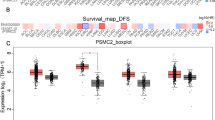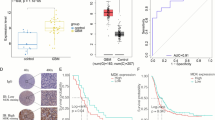Abstract
Background
Glioblastoma(GBM) is the most common primary tumor of the central nervous system with an extremely dismal prognosis. Many progresses have been made such as the discovery of new molecular biomarkers and target drugs especially IDH inhibitors. However, GBM prognosis is still poor, which requires more biomarkers and drug targets for more precision classification and treatment.
Materials and methods
Potential prognostic biomarkers of GBM were screened by TCGA database, and ectopic up-regulation of PARP14 was identified. Expression and clinical significance of PARP14 were detected in our GBM cohort consisting of 143 patients with gross total surgical resection. Related genes with PARP14 were further screened and identified by in silico analysis and in vitro experiments. The expression and prognostic significance of SAMD9 and SAMD9L were verified with IHC and survival analysis in our cohort.
Results
PARP14 was up-regulated in GBM compared with non-tumor adjacent tissues. PARP14 correlated with poor prognosis and can be regarded as an independent prognostic biomarker of GBM. PARP14 expression was positively associated with SAMD9 and SAMD9L in GBM. In GBM cells, PARP14 could increase the expression of SAMD9 and SAMD9L. SAMD9 and SAMD9L were highly expressed in high-PARP14 subset and were both prognostic biomarkers of GBM. Moreover, PARP14 increased GBM proliferation by inducing SAMD9 and SAMD9L expression.
Conclusions
PARP14, SAMD9, and SAMD9L are prognostic biomarkers of GBM predicting poor prognosis. PARP14 promotes GBM cell proliferation by inducing SAMD9 and SAMD9L expression. Our results indicate that PARP14/SAMD9/SAMD9L are prognostic biomarkers and potential drug targets of GBM.




Similar content being viewed by others
References
Jacob F, Salinas RD, Zhang DY et al (2020) A patient-derived glioblastoma organoid model and biobank recapitulates inter- and intra-tumoral heterogeneity. Cell 180(1):188–204 e122. https://doi.org/10.1016/j.cell.2019.11.036
Louis DN, Perry A, Wesseling P et al (2021) The 2021 WHO Classification of Tumors of the Central Nervous System: a summary. Neuro Oncol 23(8):1231–1251. https://doi.org/10.1093/neuonc/noab106
Omuro A, DeAngelis LM (2013) Glioblastoma and other malignant gliomas: a clinical review. JAMA 310(17):1842–1850. https://doi.org/10.1001/jama.2013.280319
Yang K, Wu Z, Zhang H et al (2022) Glioma targeted therapy: insight into future of molecular approaches. Mol Cancer 21(1):39. https://doi.org/10.1186/s12943-022-01513-z
Alexander BM, Cloughesy TF (2017) Adult glioblastoma. J Clin Oncol 35(21):2402–2409. https://doi.org/10.1200/JCO.2017.73.0119
Ahel I, Ahel D, Matsusaka T et al (2008) Poly(ADP-ribose)-binding zinc finger motifs in DNA repair/checkpoint proteins. Nature 451(7174):81–85. https://doi.org/10.1038/nature06420
Herceg Z, Wang ZQ (2001) Functions of poly(ADP-ribose) polymerase (PARP) in DNA repair, genomic integrity and cell death. Mutat Res 477(1–2):97–110. https://doi.org/10.1016/s0027-5107(01)00111-7
Langelier MF, Ruhl DD, Planck JL et al (2010) The Zn3 domain of human poly(ADP-ribose) polymerase-1 (PARP-1) functions in both DNA-dependent poly(ADP-ribose) synthesis activity and chromatin compaction. J Biol Chem 285(24):18877–18887. https://doi.org/10.1074/jbc.M110.105668
Maruyama T, Nara K, Yoshikawa H, Suzuki N (2007) Txk, a member of the non-receptor tyrosine kinase of the Tec family, forms a complex with poly(ADP-ribose) polymerase 1 and elongation factor 1alpha and regulates interferon-gamma gene transcription in Th1 cells. Clin Exp Immunol 147(1):164–175. https://doi.org/10.1111/j.1365-2249.2006.03249.x
Reinemund J, Seidel K, Steckelings UM et al (2009) Poly(ADP-ribose) polymerase-1 (PARP-1) transcriptionally regulates angiotensin AT2 receptor (AT2R) and AT2R binding protein (ATBP) genes. Biochem Pharmacol 77(12):1795–1805. https://doi.org/10.1016/j.bcp.2009.02.025
Ahel D, Horejsi Z, Wiechens N et al (2009) Poly(ADP-ribose)-dependent regulation of DNA repair by the chromatin remodeling enzyme ALC1. Science 325(5945):1240–1243. https://doi.org/10.1126/science.1177321
Barazzuol L, Jena R, Burnet NG et al (2013) Evaluation of poly (ADP-ribose) polymerase inhibitor ABT-888 combined with radiotherapy and temozolomide in glioblastoma. Radiat Oncol 8:65. https://doi.org/10.1186/1748-717X-8-65
Clarke MJ, Mulligan EA, Grogan PT et al (2009) Effective sensitization of temozolomide by ABT-888 is lost with development of temozolomide resistance in glioblastoma xenograft lines. Mol Cancer Ther 8(2):407–414. https://doi.org/10.1158/1535-7163.MCT-08-0854
Fugger K, Hewitt G, West SC, Boulton SJ (2021) Tackling PARP inhibitor resistance. Trends. Cancer 7(12):1102–1118. https://doi.org/10.1016/j.trecan.2021.08.007
Slade D (2020) PARP and PARG inhibitors in cancer treatment. Genes Dev 34(5–6):360–394. https://doi.org/10.1101/gad.334516.119
Gupta SK, Kizilbash SH, Carlson BL et al (2016) Delineation of MGMT Hypermethylation as a Biomarker for veliparib-mediated temozolomide-sensitizing therapy of glioblastoma. J Natl Cancer Inst 108(5). https://doi.org/10.1093/jnci/djv369
Aguiar RC, Takeyama K, He C et al (2005) B-aggressive lymphoma family proteins have unique domains that modulate transcription and exhibit poly(ADP-ribose) polymerase activity. J Biol Chem 280(40):33756–33765. https://doi.org/10.1074/jbc.M505408200
Iwata H, Goettsch C, Sharma A et al (2016) PARP9 and PARP14 cross-regulate macrophage activation via STAT1 ADP-ribosylation. Nat Commun 7:12849. https://doi.org/10.1038/ncomms12849
Kleine H, Poreba E, Lesniewicz K et al (2008) Substrate-assisted catalysis by PARP10 limits its activity to mono-ADP-ribosylation. Mol Cell 32(1):57–69. https://doi.org/10.1016/j.molcel.2008.08.009
Vyas S, Matic I, Uchima L et al (2014) Family-wide analysis of poly(ADP-ribose) polymerase activity. Nat Commun 5:4426. https://doi.org/10.1038/ncomms5426
Feijs KL, Verheugd P, Luscher B (2013) Expanding functions of intracellular resident mono-ADP-ribosylation in cell physiology. FEBS J 280(15):3519–3529. https://doi.org/10.1111/febs.12315
Cho SH, Ahn AK, Bhargava P et al (2011) Glycolytic rate and lymphomagenesis depend on PARP14, an ADP ribosyltransferase of the B aggressive lymphoma (BAL) family. Proc Natl Acad Sci U S A 108(38):15972–15977. https://doi.org/10.1073/pnas.1017082108
Mehrotra P, Riley JP, Patel R et al (2011) PARP-14 functions as a transcriptional switch for Stat6-dependent gene activation. J Biol Chem 286(3):1767–1776. https://doi.org/10.1074/jbc.M110.157768
Iansante V, Choy PM, Fung SW et al (2015) PARP14 promotes the Warburg effect in hepatocellular carcinoma by inhibiting JNK1-dependent PKM2 phosphorylation and activation. Nat Commun 6:7882. https://doi.org/10.1038/ncomms8882
Mashimo M, Shimizu A, Mori A et al (2022) PARP14 regulates EP4 receptor expression in human colon cancer HCA-7 cells. Biochem Biophys Res Commun 623:133–139. https://doi.org/10.1016/j.bbrc.2022.07.055
Yao N, Chen Q, Shi W et al (2019) PARP14 promotes the proliferation and gemcitabine chemoresistance of pancreatic cancer cells through activation of NF-kappaB pathway. Mol Carcinog 58(7):1291–1302. https://doi.org/10.1002/mc.23011
Zhu Y, Liu Z, Wan Y et al (2022) PARP14 promotes the growth and glycolysis of acute myeloid leukemia cells by regulating HIF-1alpha expression. Clin Immunol 242:109094. https://doi.org/10.1016/j.clim.2022.109094
Tan AC, Ashley DM, Lopez GY et al (2020) Management of glioblastoma: state of the art and future directions. CA Cancer J Clin 70(4):299–312. https://doi.org/10.3322/caac.21613
O’Connor MJ, Thakar T, Nicolae CM, Moldovan GL (2021) PARP14 regulates cyclin D1 expression to promote cell-cycle progression. Oncogene 40(30):4872–4883. https://doi.org/10.1038/s41388-021-01881-8
Chambon P, Weill JD, Mandel P (1963) Nicotinamide mononucleotide activation of new DNA-dependent polyadenylic acid synthesizing nuclear enzyme. Biochem Biophys Res Commun 11:39–43. https://doi.org/10.1016/0006-291x(63)90024-x
Weill JD, Busch S, Chambon P, Mandel P (1963) The effect of estradiol injections upon chicken liver nuclei ribonucleic acid polymerase. Biochem Biophys Res Commun 10:122–126. https://doi.org/10.1016/0006-291x(63)90036-6
Li CF, MacDonald JR, Wei RY et al (2007) Human sterile alpha motif domain 9, a novel gene identified as down-regulated in aggressive fibromatosis, is absent in the mouse. BMC Genomics 8:92. https://doi.org/10.1186/1471-2164-8-92
Narumi S, Amano N, Ishii T et al (2016) SAMD9 mutations cause a novel multisystem disorder, MIRAGE syndrome, and are associated with loss of chromosome 7. Nat Genet 48(7):792–797. https://doi.org/10.1038/ng.3569
Chen DH, Below JE, Shimamura A et al (2016) Ataxia-pancytopenia syndrome is caused by missense mutations in SAMD9L. Am J Hum Genet 98(6):1146–1158. https://doi.org/10.1016/j.ajhg.2016.04.009
Tesi B, Davidsson J, Voss M et al (2017) Gain-of-function SAMD9L mutations cause a syndrome of cytopenia, immunodeficiency, MDS, and neurological symptoms. Blood 129(16):2266–2279. https://doi.org/10.1182/blood-2016-10-743302
Russell AJ, Gray PE, Ziegler JB et al (2021) SAMD9L autoinflammatory or ataxia pancytopenia disease mutations activate cell-autonomous translational repression. Proc Natl Acad Sci USA 118(34). https://doi.org/10.1073/pnas.2110190118
Schwartz JR, Ma J, Lamprecht T et al (2017) The genomic landscape of pediatric myelodysplastic syndromes. Nat Commun 8(1):1557. https://doi.org/10.1038/s41467-017-01590-5
Zhang F, Meng X, Townsend MB et al (2019) Identification of CP77 as the third Orthopoxvirus SAMD9 and SAMD9L inhibitor with unique specificity for a rodent SAMD9L. J Virol 93(12). https://doi.org/10.1128/JVI.00225-19
Asou H, Matsui H, Ozaki Y et al (2009) Identification of a common microdeletion cluster in 7q21.3 subband among patients with myeloid leukemia and myelodysplastic syndrome. Biochem Biophys Res Commun 383(2):245–251. https://doi.org/10.1016/j.bbrc.2009.04.004
Wu L, Pu X, Wang Q et al (2016) miR-96 induces cisplatin chemoresistance in non-small cell lung cancer cells by downregulating SAMD9. Oncol Lett 11(2):945–952. https://doi.org/10.3892/ol.2015.4000
Author information
Authors and Affiliations
Corresponding author
Ethics declarations
Conflict of interest
The authors declare no competing interests.
Additional information
Publisher's Note
Springer Nature remains neutral with regard to jurisdictional claims in published maps and institutional affiliations.
Supplementary Information
Below is the link to the electronic supplementary material.
Rights and permissions
Springer Nature or its licensor (e.g. a society or other partner) holds exclusive rights to this article under a publishing agreement with the author(s) or other rightsholder(s); author self-archiving of the accepted manuscript version of this article is solely governed by the terms of such publishing agreement and applicable law.
About this article
Cite this article
Zhang, L., Chen, W., Shi, Z. et al. PARP14 correlates with GBM proliferation and poor prognosis by elevating expression of SAMD/SAMD9L. Ir J Med Sci 193, 585–593 (2024). https://doi.org/10.1007/s11845-023-03500-9
Received:
Accepted:
Published:
Issue Date:
DOI: https://doi.org/10.1007/s11845-023-03500-9




